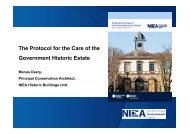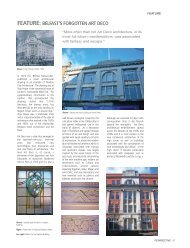Directory of Traditional Building Skills - Mourne Heritage Trust
Directory of Traditional Building Skills - Mourne Heritage Trust
Directory of Traditional Building Skills - Mourne Heritage Trust
Create successful ePaper yourself
Turn your PDF publications into a flip-book with our unique Google optimized e-Paper software.
Research into the most appropriate ways <strong>of</strong> using lime as a material for repairing historicbuildings and monuments is ongoing. Please contact the UAHS for additional information onthis subject.STONEWORK REPAIRSThis is a complex subject which requires expert guidance. The choice <strong>of</strong> techniques availableis outlined below in a simplified form.The first step in any repair scheme is to evaluate the existing state <strong>of</strong> the stonework and thedegree <strong>of</strong> intervention and repair necessary. This evaluation has implications for the types <strong>of</strong>repair techniques to be undertaken and their application as exhibited by different stones orelements <strong>of</strong> the building. When various methods <strong>of</strong> repair are matched to particular stoneproblems, sometimes in one building or even a single façade, this is referred to as a ‘palette <strong>of</strong>techniques’. The overriding principle is to retain as much as possible <strong>of</strong> the original stone.Repair Techniquesa) Complete stone replacementThis is an extreme measure, rarely necessary and very expensive, involving the completerebuilding <strong>of</strong> a façade or building. It is <strong>of</strong>ten difficult to obtain original or compatible stone andthis solution should only be used when there is complete failure <strong>of</strong> the stone or metal fixings.b) Replacement <strong>of</strong> individual stonesWeathering <strong>of</strong> stone is endlessly variable and individual stones may fail for many reasons –surface spalling, fixing failure, structural movement etc. Geological matching is critical toensure compatibility <strong>of</strong> future weathering. Stones can be replaced either to full depth or, morecommonly, to 75–100mm thickness, depending on the amount <strong>of</strong> decay <strong>of</strong> the original stone.Fixings may be necessary and should be <strong>of</strong> stainless steel to avoid corrosion.c) IndentingWhere only a small section <strong>of</strong> an original stone is damaged – e.g. by rusting around a railingfixing – it is more appropriate to replace only a small section <strong>of</strong> stone. The new stone needs tobe geologically matched, as noted above, to a similar 75–100mm depth, and should be tightlybutted to the original, without expressing the joint, and fixed as necessary. In finer work muchsmaller indents are possible, <strong>of</strong>ten held in place with epoxy grouts.d) Render repairsLarge scale render or ‘plastic’ repairs are now largely discredited though this is a usefultechnique for small scale repairs to complicated carvings or sculpture. The renders must be <strong>of</strong>a ‘s<strong>of</strong>t’ lime based mix to avoid accelerated weathering <strong>of</strong> surrounding stone. Stainless steelwire cages can be used to build up pr<strong>of</strong>iles. This is a technique for expert conservators, not acheap alternative to correct stone repairs.70











